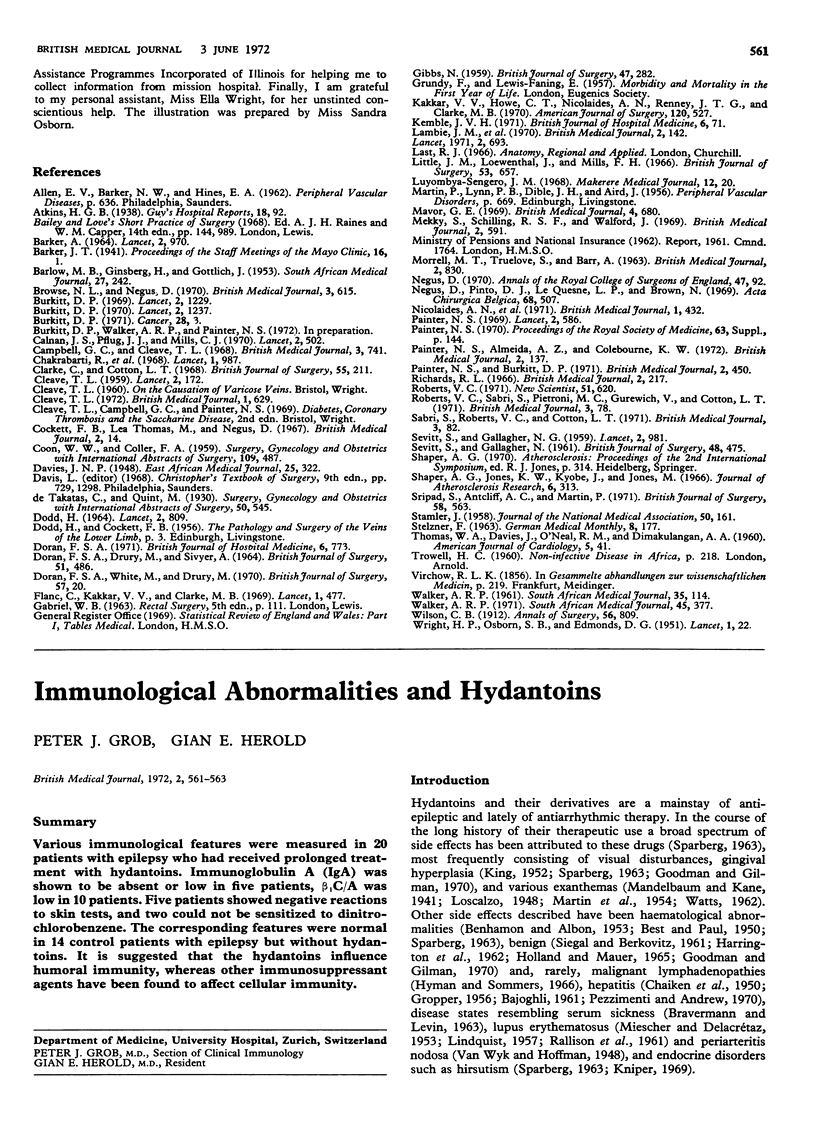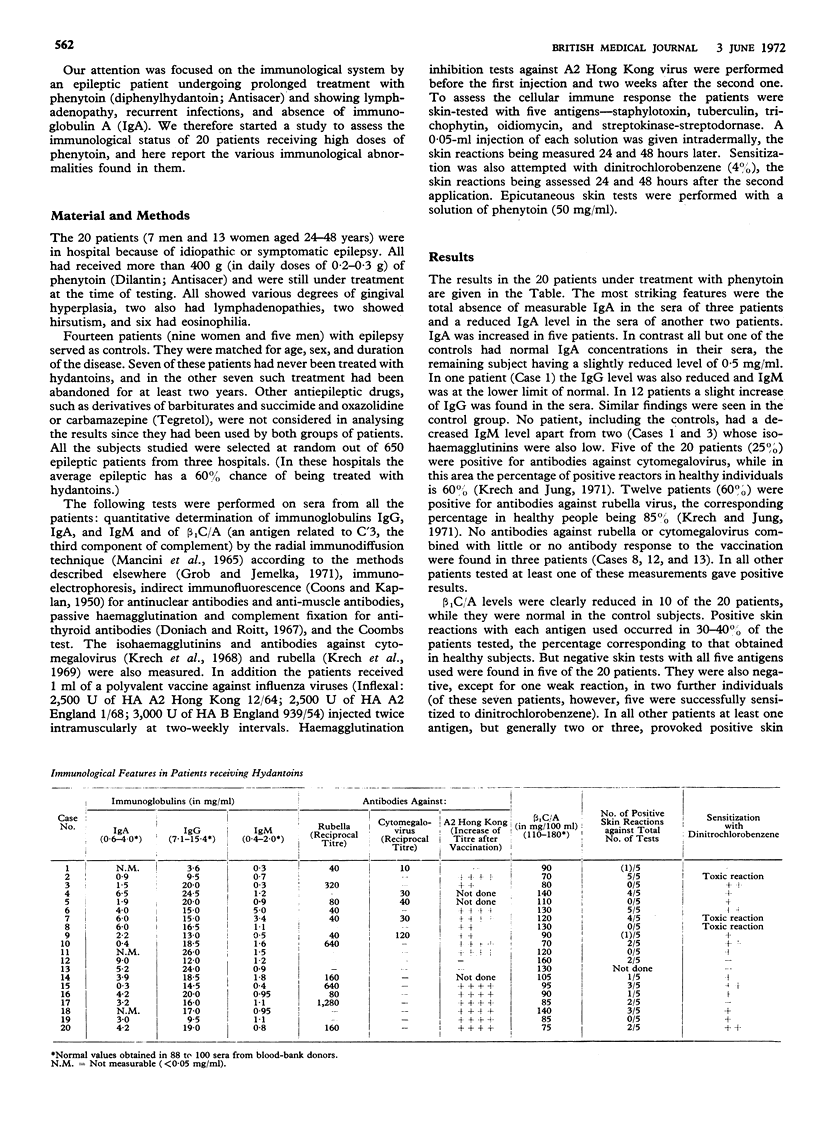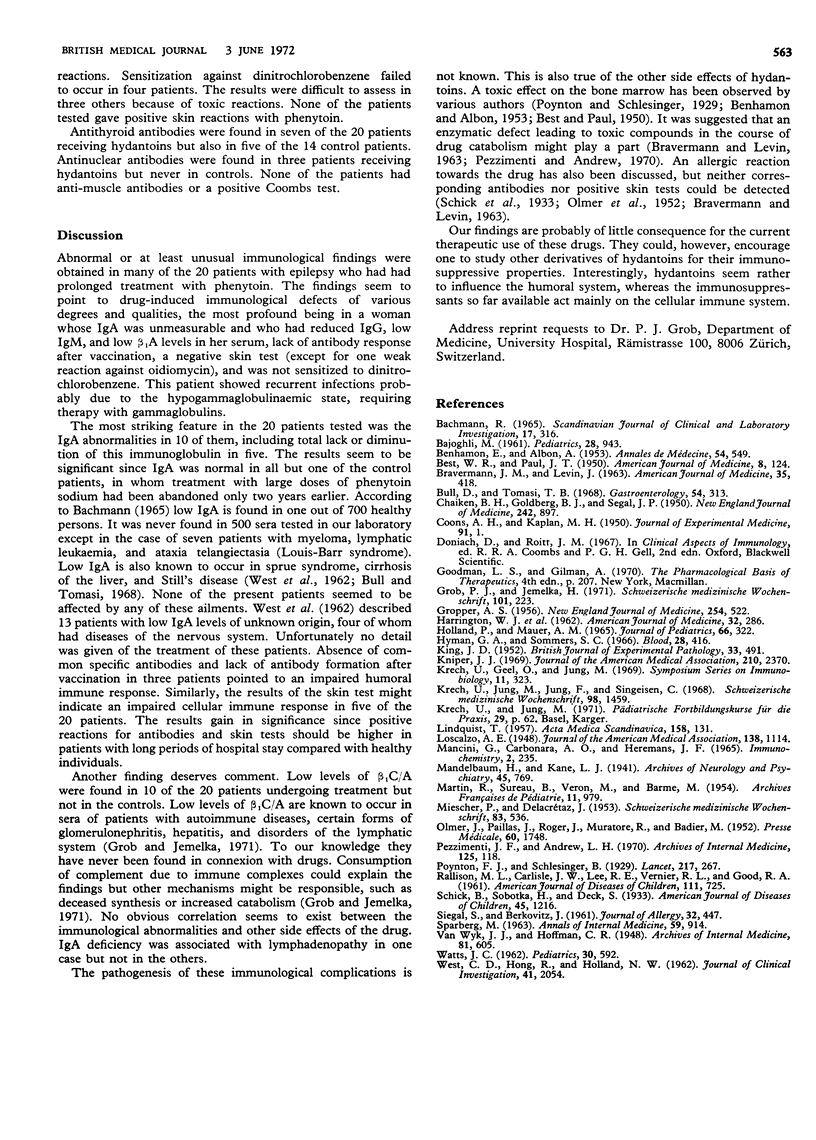Abstract
Various immunological features were measured in 20 patients with epilepsy who had received prolonged treatment with hydantoins. Immunoglobulin A (IgA) was shown to be absent or low in five patients, β1C/A was low in 10 patients. Five patients showed negative reactions to skin tests, and two could not be sensitized to dinitrochlorobenzene. The corresponding features were normal in 14 control patients with epilepsy but without hydantoins. It is suggested that the hydantoins influence humoral immunity, whereas other immunosuppressant agents have been found to affect cellular immunity.
Full text
PDF


Selected References
These references are in PubMed. This may not be the complete list of references from this article.
- BAJOGHLI M. Generalized lymphadenopathy and hepatosplenomegaly induced by diphenylhydantoin. Pediatrics. 1961 Dec;28:943–945. [PubMed] [Google Scholar]
- BEST W. R., PAUL J. T. Severe hypoplastic anemia following anticonvulsant medication; review of the literature and report of a case. Am J Med. 1950 Jan;8(1):124-30, illust. doi: 10.1016/0002-9343(50)90349-4. [DOI] [PubMed] [Google Scholar]
- Bull D. M., Tomasi T. B. Deficiency of immunoglobulin A in intestinal disease. Gastroenterology. 1968 Feb;54(2):313–320. [PubMed] [Google Scholar]
- CHAIKEN B. H., GOLDBERG B. I., SEGAL J. P. Dilantin sensitivity; report of a case of hepatitis with jaundice, pyrexia and exfoliative dermatitis. N Engl J Med. 1950 Jun 8;242(23):897–898. doi: 10.1056/NEJM195006082422304. [DOI] [PubMed] [Google Scholar]
- COONS A. H., KAPLAN M. H. Localization of antigen in tissue cells; improvements in a method for the detection of antigen by means of fluorescent antibody. J Exp Med. 1950 Jan 1;91(1):1–13. doi: 10.1084/jem.91.1.1. [DOI] [PMC free article] [PubMed] [Google Scholar]
- GROPPER A. L. Diphenylhydantoin sensitivity; report of fatal case with hepatitis and exfoliative dermatitis. N Engl J Med. 1956 Mar 15;254(11):522–523. doi: 10.1056/NEJM195603152541107. [DOI] [PubMed] [Google Scholar]
- Grob P. J., Jemelka H. Die beta-1A-Bestimmung in der Klinik. Schweiz Med Wochenschr. 1971 Feb 20;101(7):223–228. [PubMed] [Google Scholar]
- HOLLAND P., MAUER A. M. DIPHENYLHYDANOIN-INDUCED HYPERSENSITIVITY REACTION. J Pediatr. 1965 Feb;66:322–332. doi: 10.1016/s0022-3476(65)80189-5. [DOI] [PubMed] [Google Scholar]
- Hyman G. A., Sommers S. C. The development of Hodgkin's disease and lymphoma during anticonvulsant therapy. Blood. 1966 Sep;28(3):416–427. [PubMed] [Google Scholar]
- KING J. D. Experimental production of gingival hyperplasia in ferrets given epanutin (sodium diphenyl hydantoinate). Br J Exp Pathol. 1952 Oct;33(5):491–498. [PMC free article] [PubMed] [Google Scholar]
- Krech U., Jung M., Jung F., Singeisen C. Virologische und klinische Untersuchungen bei konnatelen und postnatalen Cytomegalien. Schweiz Med Wochenschr. 1968 Sep 21;98(38):1459–1469. [PubMed] [Google Scholar]
- Kuiper J. J. Lymphocytic thyroiditis possibly induced by diphenylhydantoin. JAMA. 1969 Dec 29;210(13):2370–2372. [PubMed] [Google Scholar]
- LINDQVIST T. Lupus erythematosus disseminatus after administration of mesantoin; report of two cases. Acta Med Scand. 1957 Aug 13;158(2):131–138. doi: 10.1111/j.0954-6820.1957.tb15754.x. [DOI] [PubMed] [Google Scholar]
- MARTIN R., SUREAU B., VERON M., BARME M. Accidents cutanés et ganglionnaires au cours d'un traitement par la diphényl-hydantoïne et la phénacétylurée. Arch Fr Pediatr. 1954;11(9):979–982. [PubMed] [Google Scholar]
- MIESCHER P., DELACRETAZ J. Demonstration d'un phenomène L.E. positif dans deux cas d'hypersensibilité médicamenteuse. Schweiz Med Wochenschr. 1953 Jun 6;83(23):536–538. [PubMed] [Google Scholar]
- Mancini G., Carbonara A. O., Heremans J. F. Immunochemical quantitation of antigens by single radial immunodiffusion. Immunochemistry. 1965 Sep;2(3):235–254. doi: 10.1016/0019-2791(65)90004-2. [DOI] [PubMed] [Google Scholar]
- OLMER J., PAILLAS J., ROGER J., MURATORE R., BADIER M. Manifestations ganglionnaires au cours de traitements par la méthyl-3-phényl-éthyl-5-5 hydantoine. Presse Med. 1952 Dec 25;60(82):1748–1750. [PubMed] [Google Scholar]
- Pezzimenti J. F., Hahn A. L. Anicteric hepatitis induced by diphenylhydantoin. Arch Intern Med. 1970 Jan;125(1):118–120. [PubMed] [Google Scholar]
- RALLISON M. L., CARLISLE J. W., LEE R. E., Jr, VERNIER R. L., GOOD R. A. Lupus erythematosus and Stevens-Johnson syndrome. Occurrence as reactions to anticonvulsant medication. Am J Dis Child. 1961 Jun;101:725–738. doi: 10.1001/archpedi.1961.04020070039007. [DOI] [PubMed] [Google Scholar]
- SPARBERG M. DIAGNOSTICALLY CONFUSING COMPLICATIONS OF DIPHENYLHYDANTOIN THERAPY. A REVIEW. Ann Intern Med. 1963 Dec;59:914–930. doi: 10.7326/0003-4819-59-6-914. [DOI] [PubMed] [Google Scholar]
- WATTS J. C. A fatal case of erythema multiforme exudativum (Stevens-Johnson's syndrome) following therapy with dilantin. Pediatrics. 1962 Oct;30:592–594. [PubMed] [Google Scholar]
- WEST C. D., HONG R., HOLLAND N. H. Immunoglobulin levels from the newborn period to adulthood and in immunoglobulin deficiency states. J Clin Invest. 1962 Nov;41:2054–2064. doi: 10.1172/JCI104663. [DOI] [PMC free article] [PubMed] [Google Scholar]


